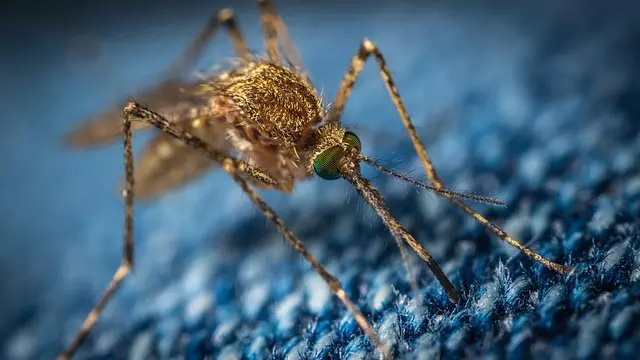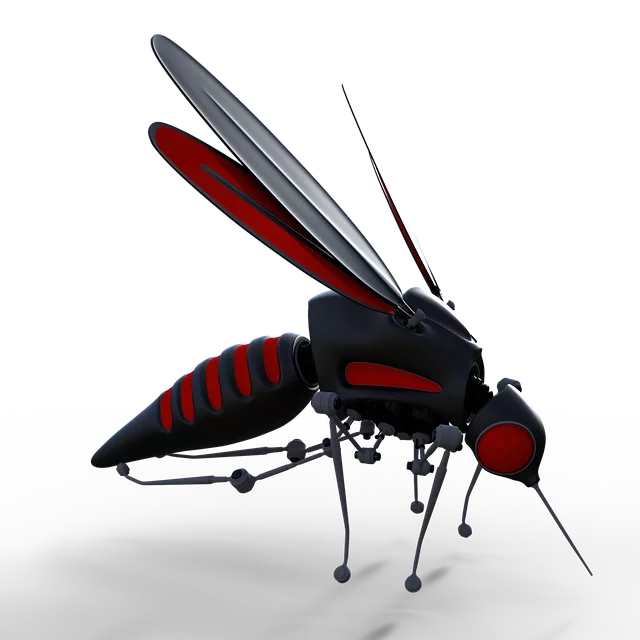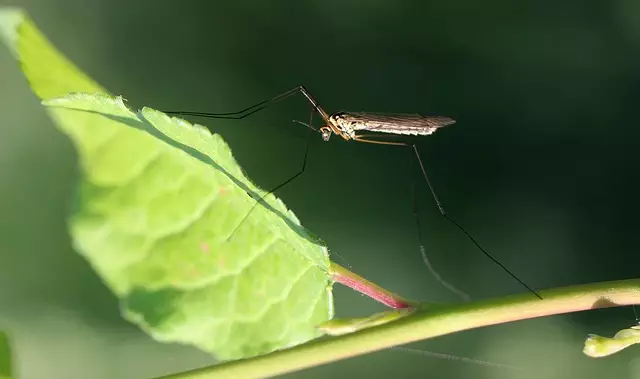Understanding mosquito biology and behavior is key to effective mosquito control. By targeting specific life stages, breeding sites, and feeding behaviors, strategic methods like removing standing water, using repellents, and installing barriers significantly reduce mosquito populations. Natural repellents offer an eco-friendly alternative, while chemical treatments provide powerful solutions during large infestations. Tailored approaches based on environmental factors and local conditions are crucial, with integrated pest management (IPM) in urban areas and localized treatments in suburban/rural regions. Seasonal fluctuations require adaptable strategies, focusing on source reduction and proactive measures like proper drainage and insect repellent use. Community involvement through education and collaboration enhances mosquito control efforts, while modern technology and genetic engineering provide innovative solutions for more sustainable practices.
Effective mosquito extermination requires a multifaceted approach, as these persistent pests pose significant health risks. Understanding mosquito biology is key to devising effective control strategies. Identifying breeding grounds and implementing targeted control measures are essential steps in mosquito management. From natural repellents to advanced technologies, this article explores diverse methods for achieving lasting mosquito control, empowering readers with the knowledge to combat these nuisances effectively.
Understanding Mosquito Biology: Key to Effective Control

Understanding the biology and behavior of mosquitoes is a crucial step in implementing effective mosquito control strategies. Mosquitoes, despite their tiny size, are complex creatures with distinct life stages. They begin as eggs laid in water, often in stagnant pools or containers, and then transform into larvae, pupae, and finally, adults. This lifecycle makes targeted interventions essential for control. Different stages require specific treatments, from larvicides to adulticides, ensuring a comprehensive approach.
By studying mosquito biology, we can identify their preferred habitats, breeding grounds, and feeding behaviors. Mosquitoes are attracted to carbon dioxide, heat, and certain chemicals present in human sweat, making outdoor activities more appealing to them during dawn and dusk. This knowledge helps in designing strategic control measures, such as removing standing water sources, using insect repellents, and implementing physical barriers, which can significantly reduce mosquito populations and the risks associated with their bites.
Identifying Breeding Grounds: Where Mosquitoes Thrive

Mosquitoes are relentless in their pursuit of suitable breeding grounds, which primarily consist of stagnant water sources. Identifying and eliminating these habitats is a crucial step in mosquito control. From abandoned containers and bird baths to clogged gutters and puddles after rainfall, these tiny creatures find sanctuary in almost any standing body of water. Regular inspection and maintenance of your surroundings can significantly reduce their numbers.
Understanding where mosquitoes thrive allows for targeted Mosquito Control measures. Removing or regularly emptying containers that collect water, ensuring proper drainage, and using mosquito-repellent plants or treatments around your property can make a substantial difference. By disrupting their breeding cycle, you not only decrease the local mosquito population but also contribute to a healthier, less pestilent environment.
Natural Repellents and Their Role in Mosquito Management

Natural repellents have emerged as an eco-friendly and sustainable approach to mosquito control, offering an alternative to chemical-based methods. These organic compounds, often derived from plants, are known for their ability to deter mosquitoes without causing harm to humans or the environment. Compounds like citronella, neem oil, and lavender are commonly used in natural insecticides and repellents. Citronella, for instance, is a well-known mosquito repellent that has been used for centuries. It can be applied topically or used in candles and diffusers to create a protective barrier against these pests.
Incorporating natural repellents into mosquito management strategies has several advantages. They are biodegradable and less likely to contaminate water sources or harm beneficial insects. Moreover, many people prefer the use of natural products for personal hygiene and well-being. By leveraging the power of nature, communities can effectively reduce mosquito populations and minimize health risks associated with these vectors of diseases like dengue and malaria.
Chemical Treatments: Pesticides and Their Applications

Chemical treatments, including pesticides, play a significant role in mosquito control. These powerful tools are designed to eliminate or repel mosquitoes and can be particularly effective in large-scale or severe infestations. Common insecticides used for mosquito management include organophosphates, carbamates, pyrethroids, and synthetic pyrethroids. Each type targets mosquitoes differently; some act as contact poisons, while others disrupt the nerve signals of the insects.
Pesticides are applied in various ways, such as spraying, fogging, or using treated barriers. For outdoor areas, spray applications target adult mosquitoes resting on foliage or water surfaces. Fogging is effective for treating large, open spaces like parks and fields. Additionally, mosquito traps baited with attractive substances can be used to reduce mosquito populations over time. These chemical methods offer quick relief but must be used cautiously, following manufacturer guidelines, to avoid potential environmental and health risks.
Targeted Mosquito Control Strategies for Specific Areas

When it comes to mosquito extermination, a targeted approach is often the most effective strategy. This involves understanding that different areas require specific methods due to varying environmental factors and mosquito behavior. For instance, urban environments present unique challenges with their man-made structures and dense populations, necessitating integrated pest management (IPM) techniques. IPM combines several strategies such as removing standing water where mosquitoes breed, applying targeted insecticides, and utilizing natural predators like birds and fish.
In contrast, suburban or rural areas may benefit from more localized treatments. This could include using mosquito traps strategically placed near bodies of water, applying ultra-low volume (ULV) insecticides to target adult mosquitoes, or implementing barrier treatments around homes and gardens. These methods are tailored to the specific needs of each area, ensuring more efficient Mosquito control while minimizing environmental impact.
Seasonal Approaches: Adapting Extermination Techniques

Mosquito populations naturally fluctuate throughout the year, with varying levels of activity depending on the season. Effective mosquito control requires adaptable strategies that align with these seasonal changes. During warmer months, when mosquitoes are most active, targeted treatments like residual insecticides and larvicides can be highly effective. These methods disrupt mosquito breeding cycles by eliminating larvae in standing water and inhibiting adult mosquito development.
In contrast, cooler seasons demand different approaches. For instance, focusing on source reduction—removing standing water where mosquitoes breed—becomes paramount. This proactive strategy includes regular cleaning of gutters, emptying containers that collect rainwater, and addressing any small puddles or stagnant pools around the property. Additionally, using mosquito repellents and ensuring proper window and door screens can significantly reduce indoor exposure during peak mosquito seasons.
Community Involvement and Education for Mosquito Prevention

Community involvement plays a pivotal role in effective mosquito control. Educating residents about the life cycle and breeding habits of mosquitoes empowers them to take proactive measures. Simple actions like eliminating standing water, maintaining proper drainage, and using insect repellent can significantly reduce mosquito populations. By fostering a culture of awareness, communities can collectively address the issue, leading to more sustainable mosquito control.
Engaging local schools, community centers, and neighborhood associations in mosquito prevention programs enhances collective effort. Educational initiatives can teach individuals how to identify potential breeding sites, report areas with stagnant water, and adopt best practices for personal protection. This collaborative approach not only reduces mosquito-borne diseases but also cultivates a sense of shared responsibility for a healthier living environment.
Emerging Technologies in Modern Mosquito Extermination

In the realm of mosquito control, modern technology has emerged as a powerful ally in the battle against these pesky vectors of disease. Innovations such as smart sensors and drones are revolutionizing mosquito extermination efforts. These advanced tools can detect and monitor mosquito populations with unprecedented accuracy, allowing for more targeted and efficient applications of control measures. For instance, drone technology enables the precise delivery of treatments to hard-to-reach areas, ensuring minimal environmental impact while maximizing effectiveness.
Additionally, genetic engineering offers another promising avenue in mosquito control. Scientists are developing genetically modified mosquitoes that either reduce their own population or carry genes conferring resistance to diseases like dengue and Zika. These emerging technologies complement traditional methods like larviciding and spraying, contributing to a more comprehensive and sustainable approach to mosquito control.
